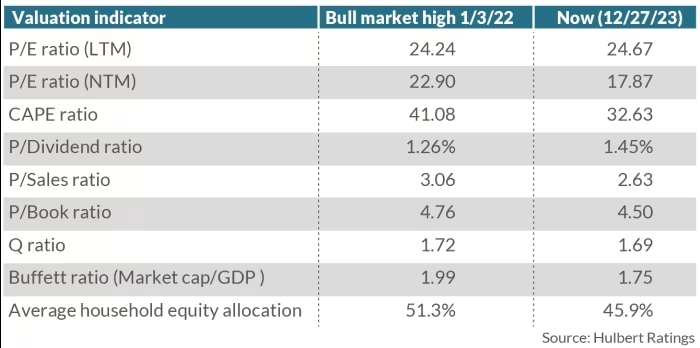Valuation Check: Assessing Stock Prices in Relation to January 2022 Highs
Presently, U.S. stocks are trading at levels similar to or slightly higher than those observed during the bull-market peak in early January 2022.
However, it’s crucial to interpret this information in the context of the market’s previous state, which was characterized by high overvaluation. Despite some improvement in valuation metrics due to the bear market of 2022, it’s worth noting that stocks remain more overpriced than at almost any other point in U.S. history.
A closer examination of various valuation indicators yields a mixed assessment. In most instances, current valuations are lower than those recorded in January 2022, with the exception of the price/earnings ratio based on trailing-12-months as-reported earnings, which is higher today. Nevertheless, these marginal improvements should be viewed in light of the market’s pronounced overvaluation in early 2022.

The Cyclically Adjusted P/E (CAPE) ratio, for instance, has shown a noteworthy decrease over the past two years, declining from 41.1 to 32.6. However, even with this reduction, the current CAPE ratio still surpasses 90.1% of all monthly readings since 1881, according to data from Yale University’s Robert Shiller.
To contextualize the CAPE’s improvement, an econometric model predicting the S&P 500’s inflation-adjusted return over the next ten years was considered. At the January 2022 high, the model forecasted a 10-year real return of minus 2.3% annualized, while the comparable forecast today is a gain of 0.7% annualized.
Although positive, this projected return may not be particularly enticing when compared to a guaranteed return of 1.7% annualized above inflation offered by 10-year TIPS from the U.S. government.
It’s important to recognize that valuation indicators possess limited predictive capabilities for short-term market movements. Even if the analysis suggests mediocre returns over the next decade, there remains the possibility of the market performing well in the short term.
Investors should approach the current market conditions with a nuanced understanding of both short-term dynamics and the broader long-term valuation landscape.




